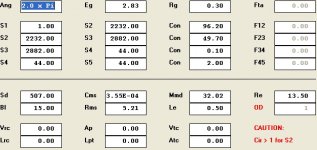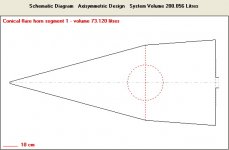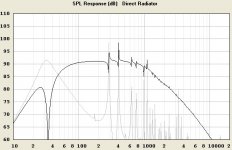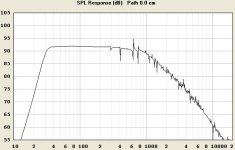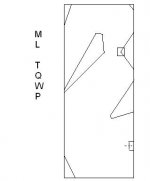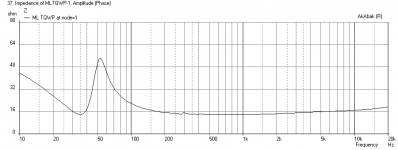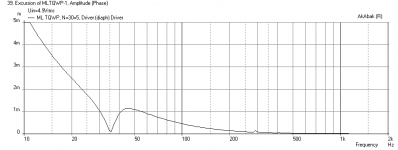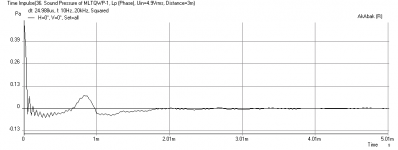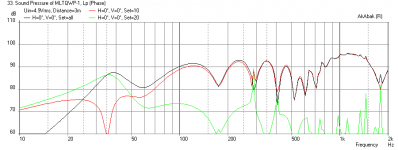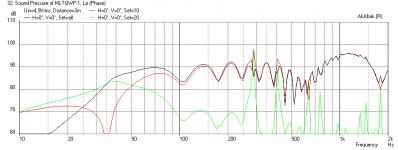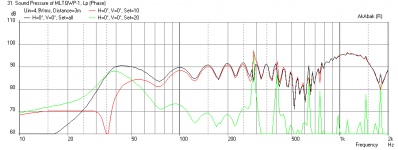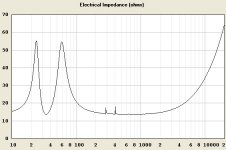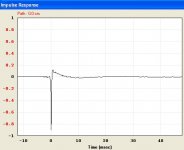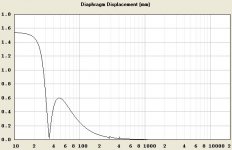Or "Best Simulated Result For Given Full-range Driver (conventional 10"-12") - will it sound good as well?"
Always using usual 12" full-range driver with different enclosures I see only one type of set-up that gives good looking SPL graph. It is mass loaded TQWP.
MJK's ML TWQP calculates the best as well. In Hornresp I can see that the bigger S2 area (and smaller L12 L23) makes better results (higher harmonics are less prominent and further shifted).
(I prefer ML as slotted front port, on some distance from the floor (it makes less prominent vertical room modes) and shorter sections, hence the enclosure folding variant in the last picture).
Group delay is 27.65msec @ 30.1Hz and better then BR result and much worse than BLH. Impulse resp is good. Efficiency is low but better than in open baffle)).
Question is: how will it sound compared to same size BLH etc. (all others with ragged combined response)?
Baffle position and room compensation I will incorporate later. Comments on cabinets,different simulations with one driver and esp. listener test opinions are welcome.
Always using usual 12" full-range driver with different enclosures I see only one type of set-up that gives good looking SPL graph. It is mass loaded TQWP.
MJK's ML TWQP calculates the best as well. In Hornresp I can see that the bigger S2 area (and smaller L12 L23) makes better results (higher harmonics are less prominent and further shifted).
(I prefer ML as slotted front port, on some distance from the floor (it makes less prominent vertical room modes) and shorter sections, hence the enclosure folding variant in the last picture).
Group delay is 27.65msec @ 30.1Hz and better then BR result and much worse than BLH. Impulse resp is good. Efficiency is low but better than in open baffle)).
Question is: how will it sound compared to same size BLH etc. (all others with ragged combined response)?
Baffle position and room compensation I will incorporate later. Comments on cabinets,different simulations with one driver and esp. listener test opinions are welcome.
Attachments
Last edited:
Hello,
please show us the Impedanz and membran movement simus,
best way would be building and measure and compair listenning
please show us the Impedanz and membran movement simus,
best way would be building and measure and compair listenning
RRR969,
I simulated your MLTQWP using AkAbak and also included the effects of finite baffle size, driver and port positions, and distance from wall. I assumed a baffle width of 53.6 cm (square root of your largest CSA), a speaker cabinet external height of 1 m, a depth of 0.5 m, driver located at 1/3 from top of cabinet, port located from 1/3 from bottom of cabinet, and I did it for 1 m, 2 m, and 3 m from back wall with listening position at 3 meters away with 3 watts of input power (4.9 volts). The plots are for 3 m, 2 m, and 1 m from wall, the driver cone displacement, the impulse response, and the impedance plot. All conditions are at 3 watts (4.9 volts). As you can see, this speaker does not like to be near a wall - it produces a lot of destructive interference at the listening position. Placed at 3 m from wall the response is much smoother. AkAbak cannot model stuffing/damping yet so, the sharp peaks and dips have to visually smoothed to imagine the effects of the damping. However, the large scale dips and peaks cannot be absorbed by the damping and will be evident upon listening or measurement. I think that in general, a TQWP will have smoother (finer resonances at higher frequencies) and thus will provide a smoother response than say a straight pipe. The mass loading helps to keep the size manageable. Seems like a good design though.
I simulated your MLTQWP using AkAbak and also included the effects of finite baffle size, driver and port positions, and distance from wall. I assumed a baffle width of 53.6 cm (square root of your largest CSA), a speaker cabinet external height of 1 m, a depth of 0.5 m, driver located at 1/3 from top of cabinet, port located from 1/3 from bottom of cabinet, and I did it for 1 m, 2 m, and 3 m from back wall with listening position at 3 meters away with 3 watts of input power (4.9 volts). The plots are for 3 m, 2 m, and 1 m from wall, the driver cone displacement, the impulse response, and the impedance plot. All conditions are at 3 watts (4.9 volts). As you can see, this speaker does not like to be near a wall - it produces a lot of destructive interference at the listening position. Placed at 3 m from wall the response is much smoother. AkAbak cannot model stuffing/damping yet so, the sharp peaks and dips have to visually smoothed to imagine the effects of the damping. However, the large scale dips and peaks cannot be absorbed by the damping and will be evident upon listening or measurement. I think that in general, a TQWP will have smoother (finer resonances at higher frequencies) and thus will provide a smoother response than say a straight pipe. The mass loading helps to keep the size manageable. Seems like a good design though.
Attachments
Thx.
Really, I simulated all types of enclosures for average 12" fullrange in Hornresp and everything came out very ragged. Worst was conventional BLH (any size, any mouth...) - due to mouth/direct radiation interference. And we can't close face of the fullrange driver; J. Dinsdale writes that it doesn't matter as mouth has much more efficiency. Simulations and listener tests do not support this point - we hear very well direct radiation in medium frequencies.
I understand why big horns "sound good", - it's in human perception of two sound centres instead of one. Two centres of sound with smooth SPL (if well calculated horn and good driver) and specific to each of them phase gradient will give us well perceived (information loaded) sound - ...localized twice. Mic will give us ups and downs. One solution for interference problem is rear facing mouth http://www.diyaudio.com/forums/subwoofers/119854-hornresp-346.html#post3483585 but it makes bigger room modes.
Bad sims came out for TQWP as well. So the only solution for MF horn dampening was closing the mouth.
Every simulation for different enclosures was the best - with one driver specs taken into account. Many simulations is fast easy to do in Hormresp with loudspeaker wizard.
And the best enclosures from all appeared to be fat MLTQWP. Martin J. King MathCAD Worksheets http://audioroundtable.com/misc/Quarter_Wave_Generators.pdf imply also that MLTQWP and MLTL behave better than others.
xrk971
I see that I have to master AkAbak.Can there be smoother sims with bafflestep/room included? (Any 10-12" Fullrange driver). What enclosure?
Do u think that the difference in sims is only room/bafflestep influence... Or AkAbak is so more accurate... Or it's the folding that is not taken into account in Hornresp?
Really, I simulated all types of enclosures for average 12" fullrange in Hornresp and everything came out very ragged. Worst was conventional BLH (any size, any mouth...) - due to mouth/direct radiation interference. And we can't close face of the fullrange driver; J. Dinsdale writes that it doesn't matter as mouth has much more efficiency. Simulations and listener tests do not support this point - we hear very well direct radiation in medium frequencies.
I understand why big horns "sound good", - it's in human perception of two sound centres instead of one. Two centres of sound with smooth SPL (if well calculated horn and good driver) and specific to each of them phase gradient will give us well perceived (information loaded) sound - ...localized twice. Mic will give us ups and downs. One solution for interference problem is rear facing mouth http://www.diyaudio.com/forums/subwoofers/119854-hornresp-346.html#post3483585 but it makes bigger room modes.
Bad sims came out for TQWP as well. So the only solution for MF horn dampening was closing the mouth.
Every simulation for different enclosures was the best - with one driver specs taken into account. Many simulations is fast easy to do in Hormresp with loudspeaker wizard.
And the best enclosures from all appeared to be fat MLTQWP. Martin J. King MathCAD Worksheets http://audioroundtable.com/misc/Quarter_Wave_Generators.pdf imply also that MLTQWP and MLTL behave better than others.
xrk971
I see that I have to master AkAbak.Can there be smoother sims with bafflestep/room included? (Any 10-12" Fullrange driver). What enclosure?
Do u think that the difference in sims is only room/bafflestep influence... Or AkAbak is so more accurate... Or it's the folding that is not taken into account in Hornresp?
Last edited by a moderator:
If you want smooth, make baffle very wide and offset driver to reduce diffraction and baffle step. Make a flat wallmount (infinite baffle) and that will give the smoothest baffle step free response. Onevreason most of my speakers are wallmounts or rear facing horns.
I did not include folds in your sim, not a big effect in general.
I did not include folds in your sim, not a big effect in general.
Inpedance curve, Impulse resp (1W), Diaphragm displacement (1W). Hornresp.
I will modify this cabinet after more sims.
I will modify this cabinet after more sims.
Attachments
Last edited:
- Status
- Not open for further replies.
- Home
- Loudspeakers
- Full Range
- Smoother sims for full-range driver
